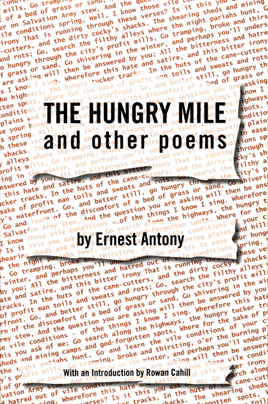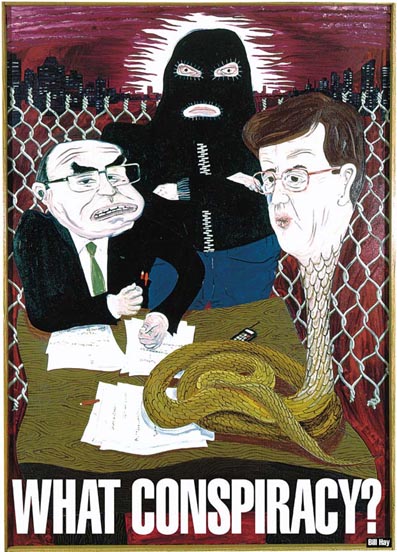Ernest Antony and the Hungry Mile (11 April 2008)
 Wharfie poet Ernest Antony was remembered and celebrated in the Sydney Convention and Exhibition Centre in Darling Harbour with the republication and launch of his very rare 1930 book 'The Hungry Mile and other poems'.
Wharfie poet Ernest Antony was remembered and celebrated in the Sydney Convention and Exhibition Centre in Darling Harbour with the republication and launch of his very rare 1930 book 'The Hungry Mile and other poems'.
The new edition has an introduction by the historian Rowan Cahill who has unearthed details of Ernest Antony's life. The actor Jack Thompson brought the audience of MUA delegates and guests to its feet with his reading of Antony's most famous poem 'The Hungry Mile'
In his introduction to the new edition historian Rowan Cahill writes about Antony:
'Ernest (Ernie) Antony was born in 1894 on a dairy farm in Yea, in rural Victoria, the family later moving to Western Australia where his father variously engaged in road building and farming. The Australian roots of the family have been traced to the Gold Rush period of the 1850s and a Portuguese immigrant with a maritime background, Joseph Antoni, and his Irish wife Julia (nee Farrell). The surname was changed to Antony during the early 1890s. Ernest left school at the age of thirteen; a family memory has him winning a school prize for his poetry, around the age of 11 or 12.'
Like most boys of his generation Antony left school in his early teens and worked at many different jobs and trades and became radicalised from his experience in city and bush. Cahill writes:
'A trade unionist, Ernest participated in strikes, gained a reputation for being a militant, was variously blacklisted for his involvements, and contributed poetry to labour movement publications. During the 1930s he was one of the many men who tramped Sydney's Hungry Mile in search of work. World War II saw him employed as a bridge and wharf carpenter for the duration, and he was prominent in associated trade union work. One of his brothers, Robert (Bob), was part of Ernest's early wanderings, until settling in the Northern Territory where he went on to help build the North Australian Workers Union in which he held No. 1 Ticket; he died in Darwin in 1970.'
Antony's poems appeared in the radical press of the 1920s and 30s and his poem 'The Hungry Mile' entered the oral culture of wharfies often without any attribution to the author. Cahill writes:
'In 1930 Antony published a slim volume of thirty-three of his poems titled The Hungry Mile and Other Poems. Some of these had been published previously in the Labour Daily, the South Coast Times (NSW), and Workers' Weekly. The book, believed to be his only published collection, was printed by Wright & Baker, of 15 Dixon Street, Sydney, a printery owned by the Communist Party of Australia (CPA). Evidence suggests Antony later planned a second, corrected, edition of his Hungry Mile poems, with omissions and additions; one new poem was titled Anzac 1944.'
The new edition of the book brings Antony's poetry back into public notice and Cahill's introduction gives the reader a welcome account of the life and times of the author. As the old Hungry Mile in Sydney's Rocks gets recognised by becoming a street name so the author of the famous poem about the workers who tramped it gets new recognition for his impressive contribution to radical and industrial culture, a recognition that has been long overdue.
While describing Antony's poetry presents problems for the modern reader there are also many seemingly fundamental ideas which ring as clear today as they did so many years ago, as Cahill points out:
'... what courses through the poems are Antony's wit, intellect, his cheeky rebelliousness, his anger, his passionate sense of social justice, and the honesty of hard won experience of Australian working life layered with philosophical ruminations. In today's world, rampaged by mean, greedy market forces and the toxic politics of oil, much of Antony's poetry is as alive and relevant as it was over seventy years ago when his Hungry Mile poem transcended the printed page and became part of history and legend.'
Ten year anniversary of Patrick dispute (7 April 2008)MUA (Maritime Union of Australia) members this week have marked the tenth anniversary of a bitter waterfront dispute that threatened the job security of some 2000 workers, and the destruction of their union.
 Across the country, seamen, wharfies and other MUA members took part in a one minute stoppage on 7 April to commemorate the Patrick dispute, during which security guards with dogs stormed every dock in Australia run by Patrick Stevedores and sacked 2000 unionised workers and forcibly removed those on the job.
Across the country, seamen, wharfies and other MUA members took part in a one minute stoppage on 7 April to commemorate the Patrick dispute, during which security guards with dogs stormed every dock in Australia run by Patrick Stevedores and sacked 2000 unionised workers and forcibly removed those on the job.
Delegates attending the first day of the national conference of the MUA, also remembered the anniversary with one minute's silence on 8 April. The union held its conference at the Sydney Convention and Exhibition Centre in Darling Harbour.
'It was an extraordinary dispute, even given the long history of organised labour in this country. How many workers have been frog-marched out of their workplace by security guards in balaclavas and dogs on chains? How many have been replaced by former defence personnel secretly trained in Dubai? All with the full cognisance and support of their elected government. These were ordinary people thrown into an extraordinary showdown.' explained MUA National Secretary Paddy Crumlin.
The anniversary came as the MUA renewed its call for documents withheld by the John Howard government (a government which had helped organise and openly supported the illegal lockout) to be released so the full truth about their war against the MUA can be told.
A week-long arts festival of film, photography, painting and theatre commemorating the dispute took place at the Australian National Maritime Museum in the Sydney
Notes
The new edition of 'The Hungry Mile and other poems' by Ernest Antony can be purchased from the MUA
Contact: Maritime Union of Australia
Phone : +61 2 9267 9134
Email : muano@mua.org.au
WWW : http://mua.org.au/